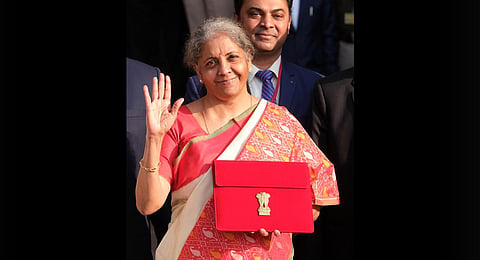

Annual budgets are all about balancing income and expenditure. But Bob's not your uncle if you happen to be India's Finance Minister and what's supposed to be a simple arithmetic exercise will be anything but that.
For Finance Minister Nirmala Sitharaman, the problem is even more complex as she presents her fourth budget next Tuesday. It's also India's second pandemic budget and with economic recovery playing hopscotch, one would expect the government to walk the whole nine yards to tackle joblessness and rising distress in the informal economy.
That said, going to market with a cap in hand will unleash the nasty side of investors and rating agencies, for whom even a rupee of extra debt translates to doomsday scenarios. But higher allocations are being sought, rightfully so, for healthcare, education, rural and urban employment schemes, housing programmes, credit guarantees for the worst-hit sectors including MSMEs among others.
Even though tax collections surprised on the upside this fiscal (and likely next fiscal), the need for market borrowings remains elevated at over Rs 12 lakh crore in FY23. In fact, Sitharaman had indicated this in her previous budget itself. As per the medium-term fiscal policy, fiscal deficit is targeted at 4.5% of GDP by FY26, implying an average 60 bps annual reduction. It means, deficit will likely squat at 6.3% or thereabouts in FY23.
But the RBI, whose ingenuity helped the government borrow at a 17-year low last year, is unlikely to play godfather. Call it a coincidence, but just days ahead of Budget 2023, the central bank conveyed as much. On Friday, Deputy Governor Dr Michael Patra reasoned that it's time for fiscal policy to take over its vanguard role, as the unsung hero RBI returns to its dutiful complementary position. Loosely translated, it means RBI will no longer anchor long-term bond rates at the sacrosanct 6% and that borrowing rates will rise. In a trailer of sorts, the 10-year benchmark rates have crossed the pre-pandemic 6.7% already and Patra's remarks simply puts across the point in the public domain.
That said, none expect a stratospheric jump in government expenditure either given Sitharaman's reluctance to spend even during the height of the pandemic. Total expenditure will likely maintain its trendline growth at around Rs 38 lakh crore. This is also the FM's essential myth buster that supply-side economics need not essentially include tax cuts or cash transfers, but regulatory measures and efficient allocation of capital and labour. Some will involve short-term costs, but ensure long-term gains, eventually leading to higher output and lower prices. But these measures primarily need two things -- time and political resolve.
Which is why some believe, the Budget will not have fireworks, but can standout just by ensuring continuity and with go-to strategies and timelines for initiatives announced in previous budgets. If you call to mind, several key announcements remained just that and focusing on their execution will be key. These include privatisation, national infrastructure pipeline, asset monetisation, bad bank, including G-secs in government bond index, and importantly direct tax reforms.
Thanks to Sitharaman's FY20 Budget, taxpayers now have two choices, but this only created administrative complexity, and the upcoming Budget is expected to smooth out the kinks. This is essential to increase compliance and broaden the tax base. Only when this happens, the next step of rationalizing tax slabs becomes realistic and doable, perhaps next year or just in time for 2024 general elections. While at it, Sitharaman must also ease compliance for taxpayers, who have been facing inexplicable technical glitches, besides clarity on equalisation levy, and on cryptocurrencies.
As for corporate taxes, the 2019 tax cuts helped firms gain higher profitability. It's the turn of companies to return the favour by embarking on a capex mahotsav. Banks too are waiting for the investment cycle to take off for credit growth to crack double digits. This will also partly address the spotlight on job creation. Even though unemployment rate is back to pre-pandemic levels of 7%, this is due to low labour participation and for broad-based improvement in jobs, the FM will likely fast forward infrastructure projects, besides increasing allocation for MNREGA.
Evidently, focus areas include healthcare and government allocation should be higher, particularly for programmes like Ayushman Bharat that are severely under funded. Besides, the budget should throw renewed light on doubling of agricultural income, following the embarrassing rollback of farm laws.
As for privatisation, the government should move on from taking the applause for Air India sale and step on the gas for privatizing banks and insurance companies. Hitting the right notes, the recent policy on public enterprises in strategic sectors marks the first step to pursue large scale divestments.
ALSO SEE: